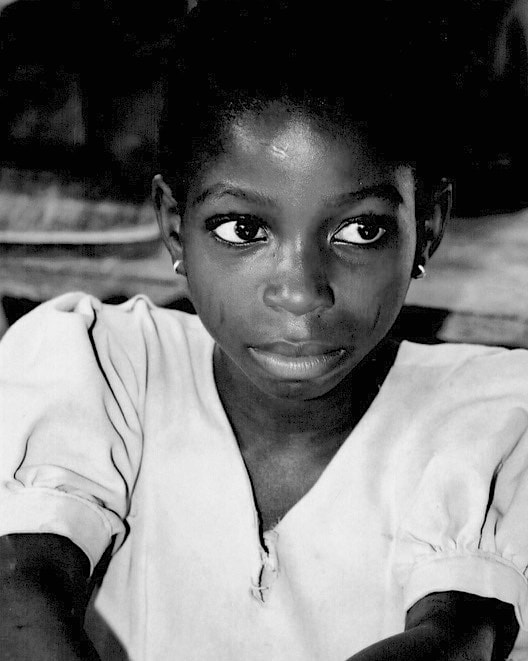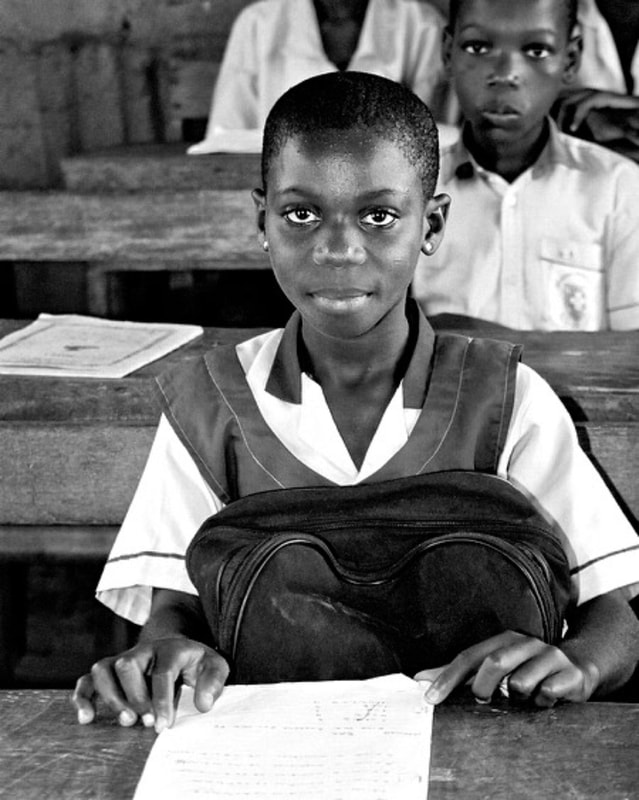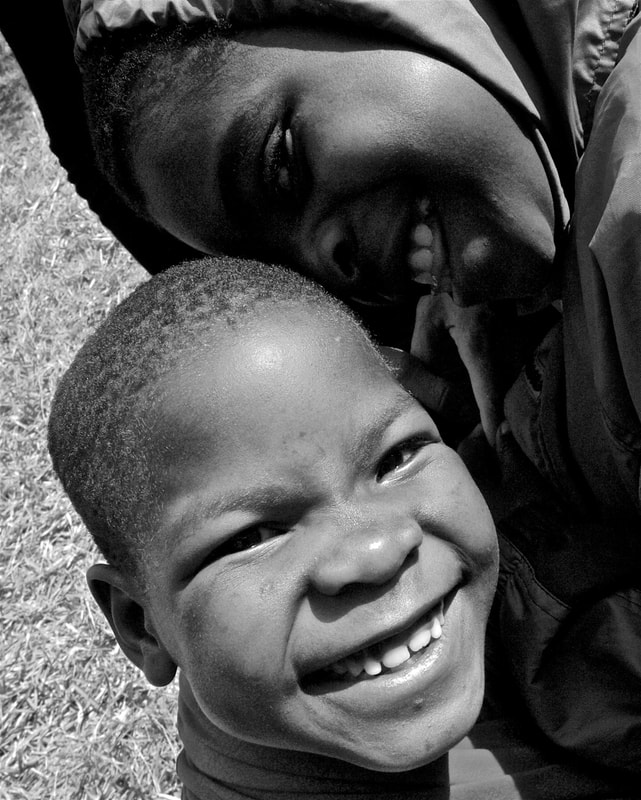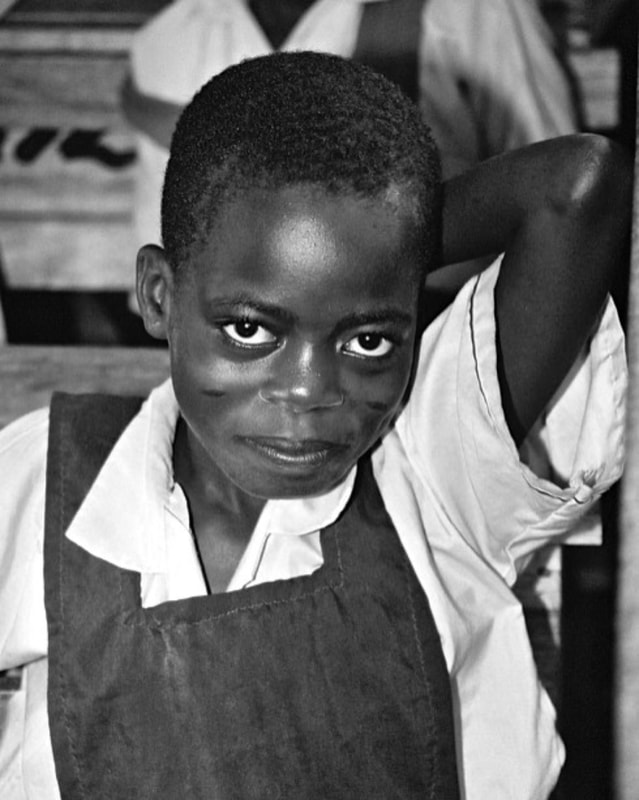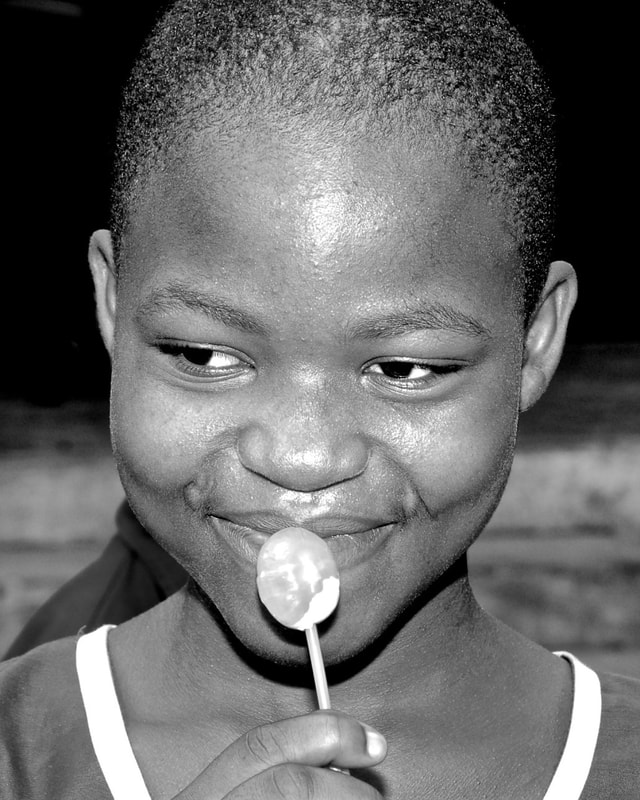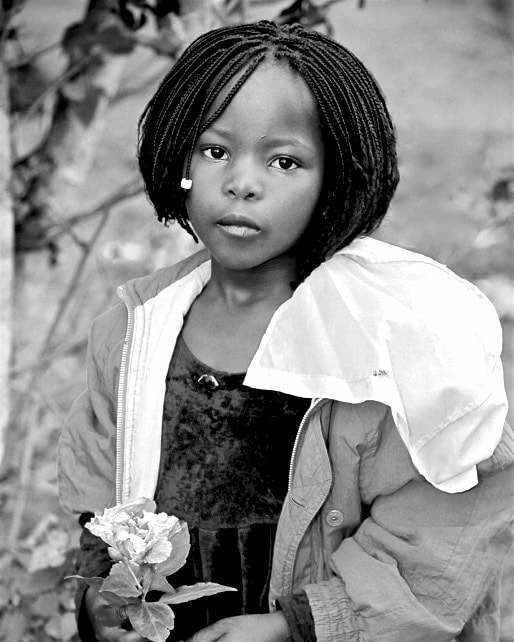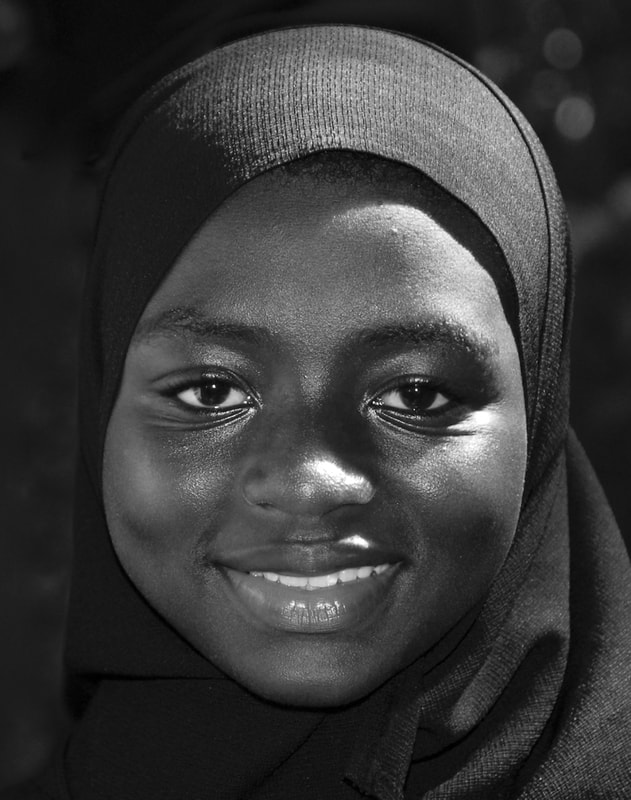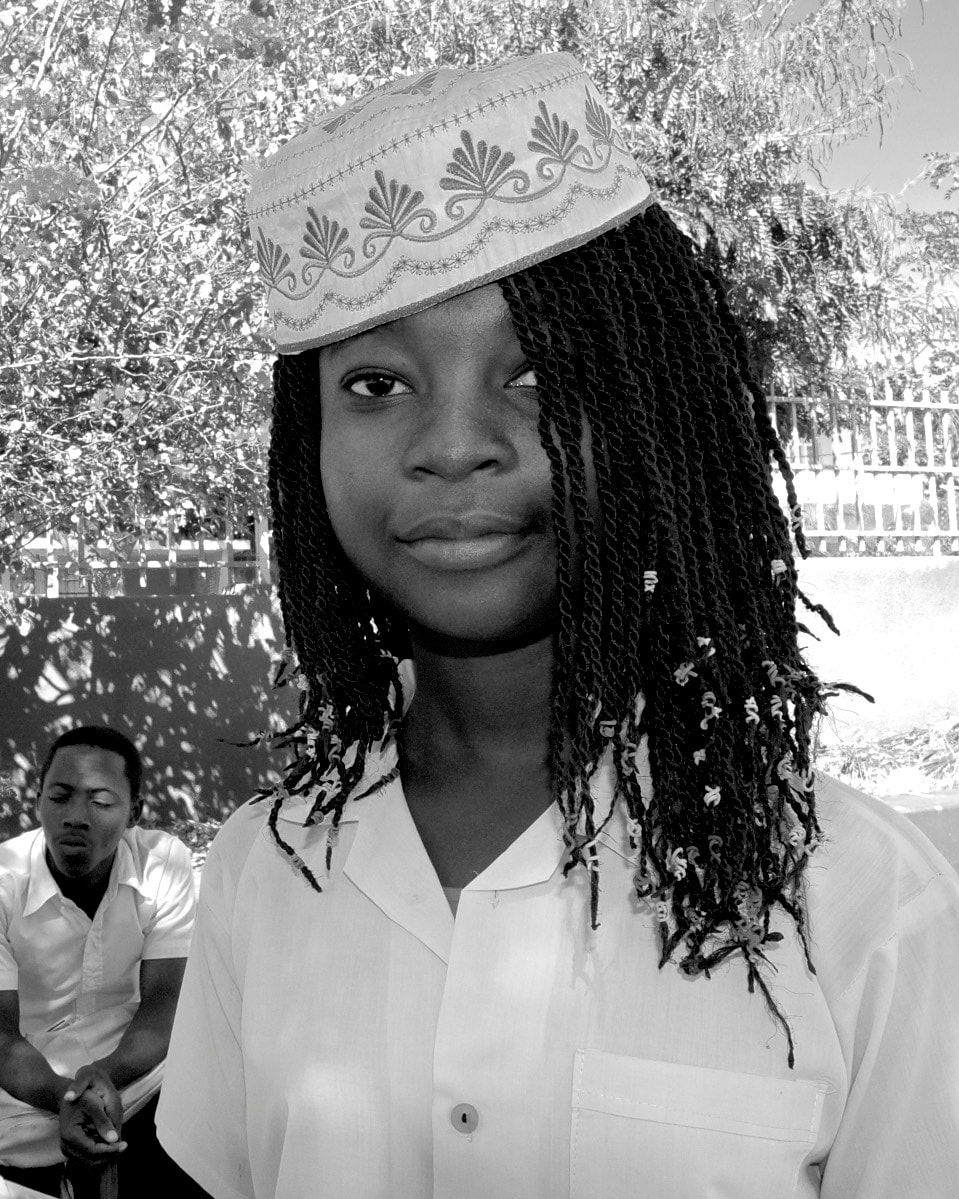Nyive-Kalakala Primary School, Togo
After driving 20 kilometers through heavy bush, a clearing is reached and a large sign proclaims this as the location of Nyive-Kalakala Primary School. The kindly Adou Mawuena, principal of this 200-student school, welcomes us. The school is in pretty bad repair with many of the mud bricks having eroded away, leaving gaping spaces below the window openings.
Inside I find some very determined children sitting two to a desk. Adou introduces me to each class but between my long-lost French vocabulary and the local dialect, I can’t follow what he says. But he gets it across to me that because the children’s education is considered so important, we cannot interrupt for long. Parents give up a lot of their income to have their children in this school and they expect time to be spent directly on school tasks. I am clearly not in the category of “teachable moment” and I content myself with photographing these beautiful children.
After driving 20 kilometers through heavy bush, a clearing is reached and a large sign proclaims this as the location of Nyive-Kalakala Primary School. The kindly Adou Mawuena, principal of this 200-student school, welcomes us. The school is in pretty bad repair with many of the mud bricks having eroded away, leaving gaping spaces below the window openings.
Inside I find some very determined children sitting two to a desk. Adou introduces me to each class but between my long-lost French vocabulary and the local dialect, I can’t follow what he says. But he gets it across to me that because the children’s education is considered so important, we cannot interrupt for long. Parents give up a lot of their income to have their children in this school and they expect time to be spent directly on school tasks. I am clearly not in the category of “teachable moment” and I content myself with photographing these beautiful children.
Koforidua, Ghana
As with all the schools I visit, I am invited to photograph the students. This girl sat in the middle of the classroom, at the usual desk for two, but she sat alone. Something about her caused me to make her portrait. She seemed so composed, so capable and so focused on just being in school.
I presented this photograph to Marguerite Axell upon her retirement as international officer for Läräforbundit, the Swedish teachers association. Marguerite spent a great deal of her life working in Africa for the benefit of children and teachers. I thought that this child might achieve the kind of success Marguerite supported in her lifetime of development work.
As with all the schools I visit, I am invited to photograph the students. This girl sat in the middle of the classroom, at the usual desk for two, but she sat alone. Something about her caused me to make her portrait. She seemed so composed, so capable and so focused on just being in school.
I presented this photograph to Marguerite Axell upon her retirement as international officer for Läräforbundit, the Swedish teachers association. Marguerite spent a great deal of her life working in Africa for the benefit of children and teachers. I thought that this child might achieve the kind of success Marguerite supported in her lifetime of development work.
Mosteiro Mater Dolorosa Orphanage, Lichinga, Mozambique
We arrive in front of the church where we are greeted by a group of children who sing for us and scatter flower petals in our path. Then they walk us to the orphanage buildings, proudly showing off their home. It’s a nice building and well appointed for the 40 children who live here. Two little ones take my hands on the walk back. I think of the loss each one has suffered—parents and family—and I wonder what they dream.
In the church, two lines of children enter, singing and dancing in slow rhythm. All the elements of the service include the children as key players and they add luster to what could otherwise be a rather staid experience.
On our return to town, 15 children and the housemother pile into the truck box and sing us back to the hotel. As we go by the hospital and morgue, they fall silent, lighting up again only after we are well past.
We arrive in front of the church where we are greeted by a group of children who sing for us and scatter flower petals in our path. Then they walk us to the orphanage buildings, proudly showing off their home. It’s a nice building and well appointed for the 40 children who live here. Two little ones take my hands on the walk back. I think of the loss each one has suffered—parents and family—and I wonder what they dream.
In the church, two lines of children enter, singing and dancing in slow rhythm. All the elements of the service include the children as key players and they add luster to what could otherwise be a rather staid experience.
On our return to town, 15 children and the housemother pile into the truck box and sing us back to the hotel. As we go by the hospital and morgue, they fall silent, lighting up again only after we are well past.
Akatoshie School, Rural Accra, Ghana
On the way to Kumasi in central Ghana, we stop at some of the schools taking part in a Canadian education program. The names of the schools are Ashallaga Primary, Opah Primary and Akatoshie Primary. The buildings range from an eroding mud block structure to buildings of substantial concrete construction.
The children within are the constants, beautiful kids, attentive and working hard with their teachers to achieve success. I’m impressed with the skills of the teachers; their delivery of lessons and their obvious care for all of the students.
In a lane outside Akatoshie School, I stop to visit a mother with a nursing baby, a toddler and a lovely daughter of about six years. They live in a squalid hut, the earthen floor of which is littered with rags. From within, the sound of a man’s ragged coughing reaches me.
On the way to Kumasi in central Ghana, we stop at some of the schools taking part in a Canadian education program. The names of the schools are Ashallaga Primary, Opah Primary and Akatoshie Primary. The buildings range from an eroding mud block structure to buildings of substantial concrete construction.
The children within are the constants, beautiful kids, attentive and working hard with their teachers to achieve success. I’m impressed with the skills of the teachers; their delivery of lessons and their obvious care for all of the students.
In a lane outside Akatoshie School, I stop to visit a mother with a nursing baby, a toddler and a lovely daughter of about six years. They live in a squalid hut, the earthen floor of which is littered with rags. From within, the sound of a man’s ragged coughing reaches me.
La-Bawaleshie School, Accra, Ghana
I visit classrooms to photograph the children inside and to incite disruption and hilarity wherever I can. The children seem interested in having me in their midst and respond well to my camera. I suggest to one class that they may like to gather around their teacher for some pictures. That’s the trigger that releases the pent-up pre-recess excitement and the kids swarm around her in great glee. She nearly disappears in the mob.
I walk the school ground during recess and many of the children take part in the photography. The headmistress, Mary Owusu, tells me that the children in this school come from families with low-income jobs and that their parents leave them to pretty much fend for themselves. Also, many of the girls work as domestic servants in homes near the school after classes let out.
I visit classrooms to photograph the children inside and to incite disruption and hilarity wherever I can. The children seem interested in having me in their midst and respond well to my camera. I suggest to one class that they may like to gather around their teacher for some pictures. That’s the trigger that releases the pent-up pre-recess excitement and the kids swarm around her in great glee. She nearly disappears in the mob.
I walk the school ground during recess and many of the children take part in the photography. The headmistress, Mary Owusu, tells me that the children in this school come from families with low-income jobs and that their parents leave them to pretty much fend for themselves. Also, many of the girls work as domestic servants in homes near the school after classes let out.
Principal’s Daughter, Namaacha, Mozambique
Students come to the Teachers’ College after completing seven years of public schooling and remain for two years plus a year of practicum. By age 18, their teacher education is complete and they are placed in schools. These students acquire two more years of schooling as well as their teacher training while attending the college. A new program will not allow students to achieve higher school standing but they will spend more time learning teaching methods. Those students will leave the College with only Grade 7 plus a teacher’s primary certificate.
Efforts are being made to recruit many more girls. Now, 80 percent of the teaching profession is comprised of males. By keeping the level of school achievement low at graduation and by recruiting young women, the Ministry will be able to “lock in” these girls at the lowest qualifications and salary positions. Very few will ever be able to upgrade once they start teaching. This sounds like an IMF idea, meant to keep the cost of teachers to the country (and the money lenders) as low as possible.
Students come to the Teachers’ College after completing seven years of public schooling and remain for two years plus a year of practicum. By age 18, their teacher education is complete and they are placed in schools. These students acquire two more years of schooling as well as their teacher training while attending the college. A new program will not allow students to achieve higher school standing but they will spend more time learning teaching methods. Those students will leave the College with only Grade 7 plus a teacher’s primary certificate.
Efforts are being made to recruit many more girls. Now, 80 percent of the teaching profession is comprised of males. By keeping the level of school achievement low at graduation and by recruiting young women, the Ministry will be able to “lock in” these girls at the lowest qualifications and salary positions. Very few will ever be able to upgrade once they start teaching. This sounds like an IMF idea, meant to keep the cost of teachers to the country (and the money lenders) as low as possible.
Kakum National Park, Ghana
Francis walks me to the start of the rope bridges that span the forest canopy. The last in line, I wait behind a group of high school students out from Accra on a field trip. They enjoy themselves as they wait despite frequent admonishments from their teacher. Soon enough, some tentative questions are asked of me, mainly concerning my Nikon camera. “Take my picture,” one of the older boys ventures. I ask the teacher if he would like to have some photographs of the students as they venture out onto the skywalk. Aziz is headmaster of this residential school. He tells me that most of these students are orphans.
Once on the platform where the walk begins, one of the girls from the group starts to walk away, tears filling her eyes. She is plainly fearful of the rope bridges. I gently intercept her and encourage her to turn back. With her twin sister, she steps out onto the first bridge.
Francis walks me to the start of the rope bridges that span the forest canopy. The last in line, I wait behind a group of high school students out from Accra on a field trip. They enjoy themselves as they wait despite frequent admonishments from their teacher. Soon enough, some tentative questions are asked of me, mainly concerning my Nikon camera. “Take my picture,” one of the older boys ventures. I ask the teacher if he would like to have some photographs of the students as they venture out onto the skywalk. Aziz is headmaster of this residential school. He tells me that most of these students are orphans.
Once on the platform where the walk begins, one of the girls from the group starts to walk away, tears filling her eyes. She is plainly fearful of the rope bridges. I gently intercept her and encourage her to turn back. With her twin sister, she steps out onto the first bridge.
Pemba, Mozambique
The new high school where we hold our workshop is a testament of the high importance Mozambique places on the education of its children. The rooms are all finished with new black boards in place but no desks in most of the rooms. In the field behind this building is another one constructed with reed walls and a tin roof. This is the old school, still in use, with its glassless window openings and mud brick room dividers. That school runs three shifts daily and soon all of its denizens will be taking classes in the new structure.
I photograph this girl “hanging out” with other high school students. She is quite a contrast from girls in the countryside and she has a very good impression of herself. Good for her, I think, and good luck as well.
The new high school where we hold our workshop is a testament of the high importance Mozambique places on the education of its children. The rooms are all finished with new black boards in place but no desks in most of the rooms. In the field behind this building is another one constructed with reed walls and a tin roof. This is the old school, still in use, with its glassless window openings and mud brick room dividers. That school runs three shifts daily and soon all of its denizens will be taking classes in the new structure.
I photograph this girl “hanging out” with other high school students. She is quite a contrast from girls in the countryside and she has a very good impression of herself. Good for her, I think, and good luck as well.
